Business Communication Models PDF
VerifiedAdded on 2021/01/01
|12
|2796
|118
AI Summary
Contribute Materials
Your contribution can guide someone’s learning journey. Share your
documents today.

Communication Skills for
Business
Business
Secure Best Marks with AI Grader
Need help grading? Try our AI Grader for instant feedback on your assignments.
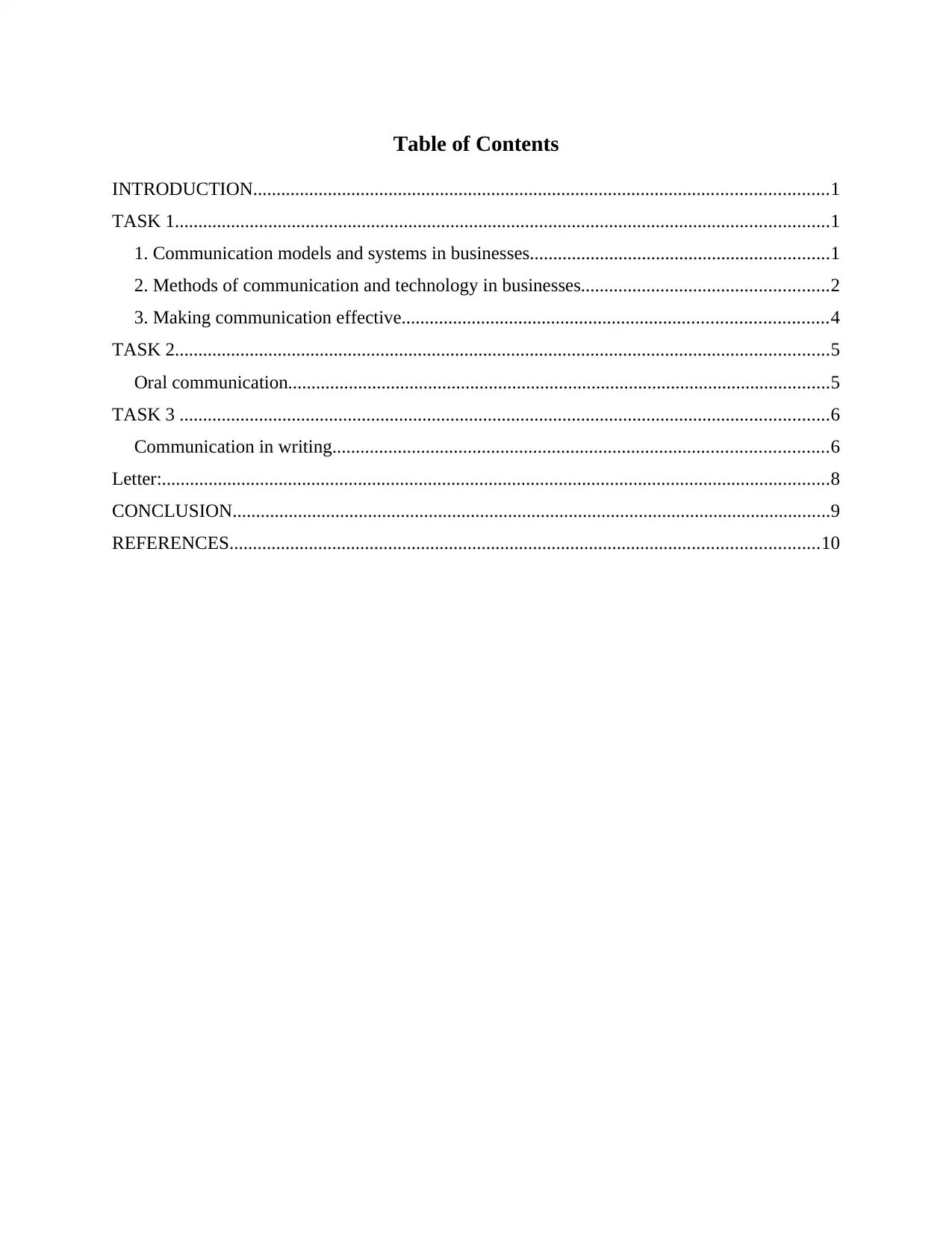
Table of Contents
INTRODUCTION...........................................................................................................................1
TASK 1............................................................................................................................................1
1. Communication models and systems in businesses................................................................1
2. Methods of communication and technology in businesses.....................................................2
3. Making communication effective...........................................................................................4
TASK 2............................................................................................................................................5
Oral communication....................................................................................................................5
TASK 3 ...........................................................................................................................................6
Communication in writing..........................................................................................................6
Letter:...............................................................................................................................................8
CONCLUSION................................................................................................................................9
REFERENCES..............................................................................................................................10
INTRODUCTION...........................................................................................................................1
TASK 1............................................................................................................................................1
1. Communication models and systems in businesses................................................................1
2. Methods of communication and technology in businesses.....................................................2
3. Making communication effective...........................................................................................4
TASK 2............................................................................................................................................5
Oral communication....................................................................................................................5
TASK 3 ...........................................................................................................................................6
Communication in writing..........................................................................................................6
Letter:...............................................................................................................................................8
CONCLUSION................................................................................................................................9
REFERENCES..............................................................................................................................10
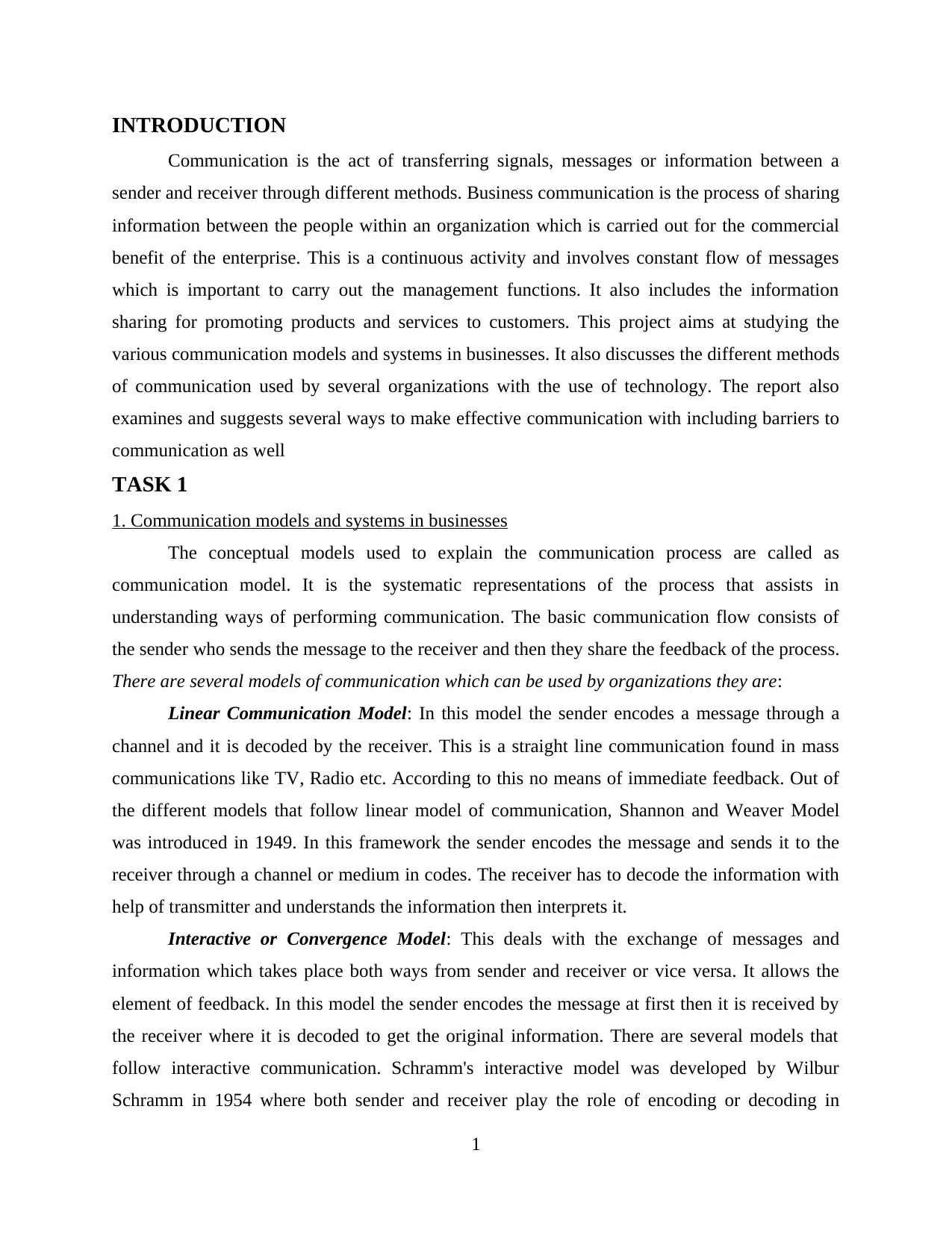
INTRODUCTION
Communication is the act of transferring signals, messages or information between a
sender and receiver through different methods. Business communication is the process of sharing
information between the people within an organization which is carried out for the commercial
benefit of the enterprise. This is a continuous activity and involves constant flow of messages
which is important to carry out the management functions. It also includes the information
sharing for promoting products and services to customers. This project aims at studying the
various communication models and systems in businesses. It also discusses the different methods
of communication used by several organizations with the use of technology. The report also
examines and suggests several ways to make effective communication with including barriers to
communication as well
TASK 1
1. Communication models and systems in businesses
The conceptual models used to explain the communication process are called as
communication model. It is the systematic representations of the process that assists in
understanding ways of performing communication. The basic communication flow consists of
the sender who sends the message to the receiver and then they share the feedback of the process.
There are several models of communication which can be used by organizations they are:
Linear Communication Model: In this model the sender encodes a message through a
channel and it is decoded by the receiver. This is a straight line communication found in mass
communications like TV, Radio etc. According to this no means of immediate feedback. Out of
the different models that follow linear model of communication, Shannon and Weaver Model
was introduced in 1949. In this framework the sender encodes the message and sends it to the
receiver through a channel or medium in codes. The receiver has to decode the information with
help of transmitter and understands the information then interprets it.
Interactive or Convergence Model: This deals with the exchange of messages and
information which takes place both ways from sender and receiver or vice versa. It allows the
element of feedback. In this model the sender encodes the message at first then it is received by
the receiver where it is decoded to get the original information. There are several models that
follow interactive communication. Schramm's interactive model was developed by Wilbur
Schramm in 1954 where both sender and receiver play the role of encoding or decoding in
1
Communication is the act of transferring signals, messages or information between a
sender and receiver through different methods. Business communication is the process of sharing
information between the people within an organization which is carried out for the commercial
benefit of the enterprise. This is a continuous activity and involves constant flow of messages
which is important to carry out the management functions. It also includes the information
sharing for promoting products and services to customers. This project aims at studying the
various communication models and systems in businesses. It also discusses the different methods
of communication used by several organizations with the use of technology. The report also
examines and suggests several ways to make effective communication with including barriers to
communication as well
TASK 1
1. Communication models and systems in businesses
The conceptual models used to explain the communication process are called as
communication model. It is the systematic representations of the process that assists in
understanding ways of performing communication. The basic communication flow consists of
the sender who sends the message to the receiver and then they share the feedback of the process.
There are several models of communication which can be used by organizations they are:
Linear Communication Model: In this model the sender encodes a message through a
channel and it is decoded by the receiver. This is a straight line communication found in mass
communications like TV, Radio etc. According to this no means of immediate feedback. Out of
the different models that follow linear model of communication, Shannon and Weaver Model
was introduced in 1949. In this framework the sender encodes the message and sends it to the
receiver through a channel or medium in codes. The receiver has to decode the information with
help of transmitter and understands the information then interprets it.
Interactive or Convergence Model: This deals with the exchange of messages and
information which takes place both ways from sender and receiver or vice versa. It allows the
element of feedback. In this model the sender encodes the message at first then it is received by
the receiver where it is decoded to get the original information. There are several models that
follow interactive communication. Schramm's interactive model was developed by Wilbur
Schramm in 1954 where both sender and receiver play the role of encoding or decoding in
1
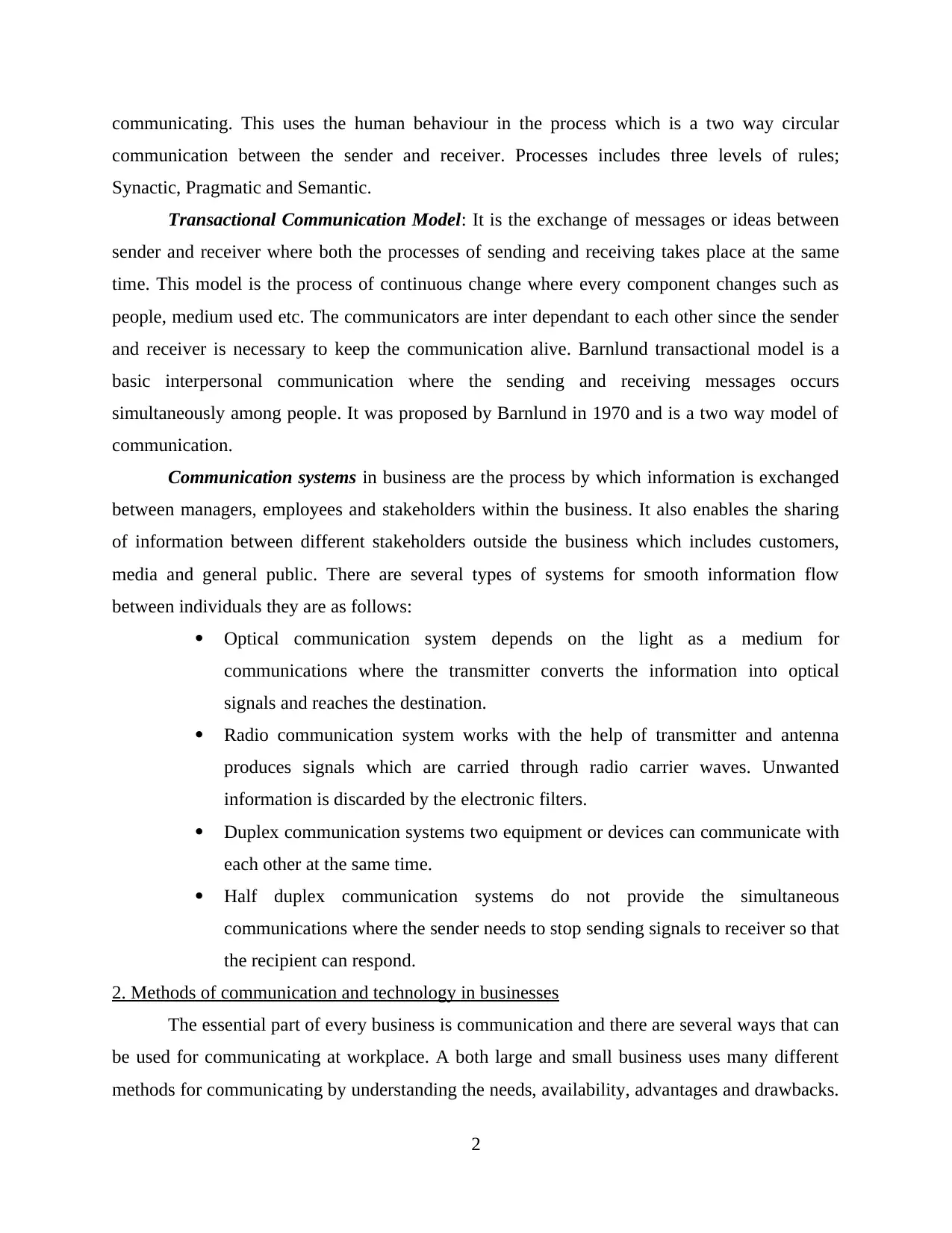
communicating. This uses the human behaviour in the process which is a two way circular
communication between the sender and receiver. Processes includes three levels of rules;
Synactic, Pragmatic and Semantic.
Transactional Communication Model: It is the exchange of messages or ideas between
sender and receiver where both the processes of sending and receiving takes place at the same
time. This model is the process of continuous change where every component changes such as
people, medium used etc. The communicators are inter dependant to each other since the sender
and receiver is necessary to keep the communication alive. Barnlund transactional model is a
basic interpersonal communication where the sending and receiving messages occurs
simultaneously among people. It was proposed by Barnlund in 1970 and is a two way model of
communication.
Communication systems in business are the process by which information is exchanged
between managers, employees and stakeholders within the business. It also enables the sharing
of information between different stakeholders outside the business which includes customers,
media and general public. There are several types of systems for smooth information flow
between individuals they are as follows:
Optical communication system depends on the light as a medium for
communications where the transmitter converts the information into optical
signals and reaches the destination.
Radio communication system works with the help of transmitter and antenna
produces signals which are carried through radio carrier waves. Unwanted
information is discarded by the electronic filters.
Duplex communication systems two equipment or devices can communicate with
each other at the same time.
Half duplex communication systems do not provide the simultaneous
communications where the sender needs to stop sending signals to receiver so that
the recipient can respond.
2. Methods of communication and technology in businesses
The essential part of every business is communication and there are several ways that can
be used for communicating at workplace. A both large and small business uses many different
methods for communicating by understanding the needs, availability, advantages and drawbacks.
2
communication between the sender and receiver. Processes includes three levels of rules;
Synactic, Pragmatic and Semantic.
Transactional Communication Model: It is the exchange of messages or ideas between
sender and receiver where both the processes of sending and receiving takes place at the same
time. This model is the process of continuous change where every component changes such as
people, medium used etc. The communicators are inter dependant to each other since the sender
and receiver is necessary to keep the communication alive. Barnlund transactional model is a
basic interpersonal communication where the sending and receiving messages occurs
simultaneously among people. It was proposed by Barnlund in 1970 and is a two way model of
communication.
Communication systems in business are the process by which information is exchanged
between managers, employees and stakeholders within the business. It also enables the sharing
of information between different stakeholders outside the business which includes customers,
media and general public. There are several types of systems for smooth information flow
between individuals they are as follows:
Optical communication system depends on the light as a medium for
communications where the transmitter converts the information into optical
signals and reaches the destination.
Radio communication system works with the help of transmitter and antenna
produces signals which are carried through radio carrier waves. Unwanted
information is discarded by the electronic filters.
Duplex communication systems two equipment or devices can communicate with
each other at the same time.
Half duplex communication systems do not provide the simultaneous
communications where the sender needs to stop sending signals to receiver so that
the recipient can respond.
2. Methods of communication and technology in businesses
The essential part of every business is communication and there are several ways that can
be used for communicating at workplace. A both large and small business uses many different
methods for communicating by understanding the needs, availability, advantages and drawbacks.
2
Paraphrase This Document
Need a fresh take? Get an instant paraphrase of this document with our AI Paraphraser
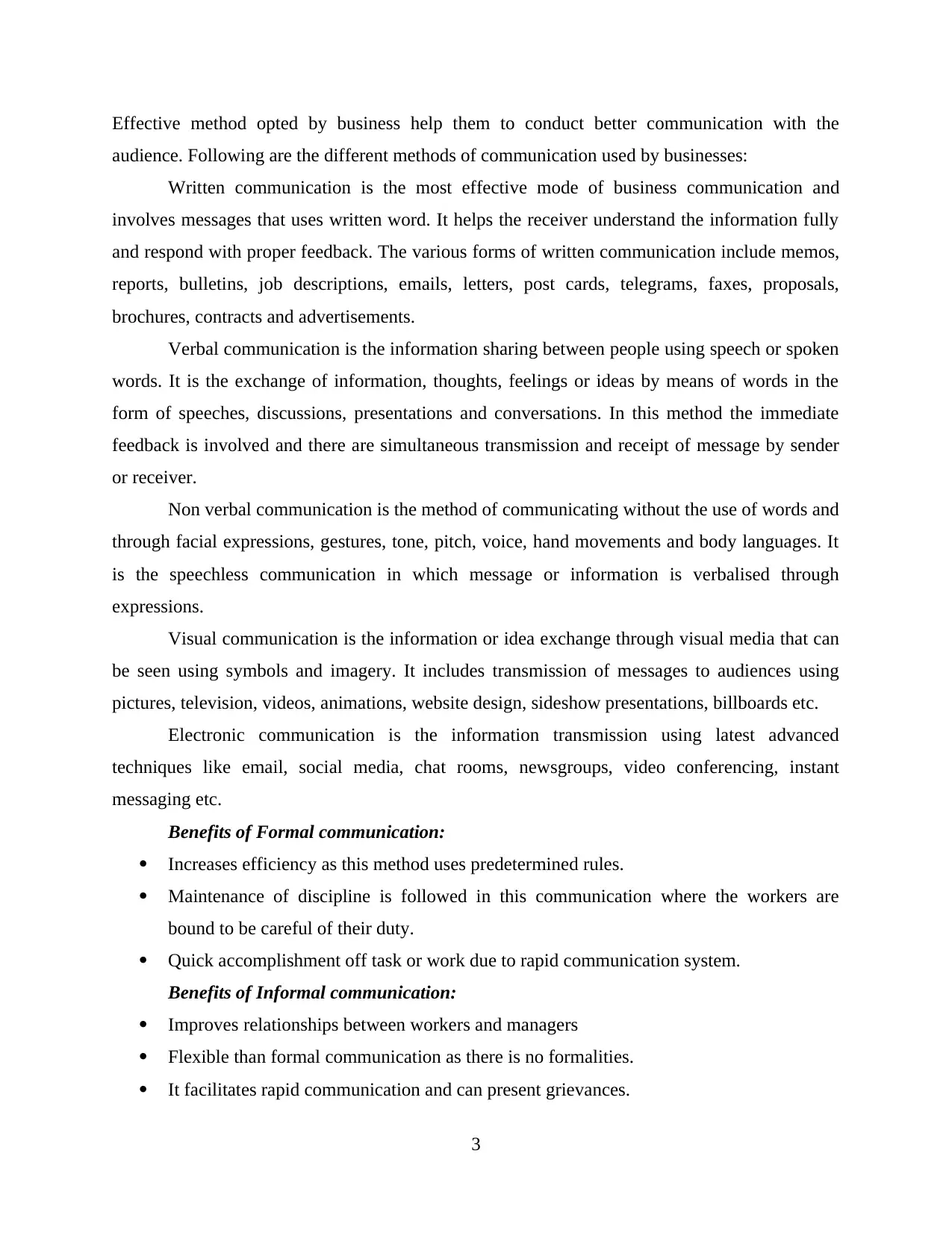
Effective method opted by business help them to conduct better communication with the
audience. Following are the different methods of communication used by businesses:
Written communication is the most effective mode of business communication and
involves messages that uses written word. It helps the receiver understand the information fully
and respond with proper feedback. The various forms of written communication include memos,
reports, bulletins, job descriptions, emails, letters, post cards, telegrams, faxes, proposals,
brochures, contracts and advertisements.
Verbal communication is the information sharing between people using speech or spoken
words. It is the exchange of information, thoughts, feelings or ideas by means of words in the
form of speeches, discussions, presentations and conversations. In this method the immediate
feedback is involved and there are simultaneous transmission and receipt of message by sender
or receiver.
Non verbal communication is the method of communicating without the use of words and
through facial expressions, gestures, tone, pitch, voice, hand movements and body languages. It
is the speechless communication in which message or information is verbalised through
expressions.
Visual communication is the information or idea exchange through visual media that can
be seen using symbols and imagery. It includes transmission of messages to audiences using
pictures, television, videos, animations, website design, sideshow presentations, billboards etc.
Electronic communication is the information transmission using latest advanced
techniques like email, social media, chat rooms, newsgroups, video conferencing, instant
messaging etc.
Benefits of Formal communication:
Increases efficiency as this method uses predetermined rules.
Maintenance of discipline is followed in this communication where the workers are
bound to be careful of their duty.
Quick accomplishment off task or work due to rapid communication system.
Benefits of Informal communication:
Improves relationships between workers and managers
Flexible than formal communication as there is no formalities.
It facilitates rapid communication and can present grievances.
3
audience. Following are the different methods of communication used by businesses:
Written communication is the most effective mode of business communication and
involves messages that uses written word. It helps the receiver understand the information fully
and respond with proper feedback. The various forms of written communication include memos,
reports, bulletins, job descriptions, emails, letters, post cards, telegrams, faxes, proposals,
brochures, contracts and advertisements.
Verbal communication is the information sharing between people using speech or spoken
words. It is the exchange of information, thoughts, feelings or ideas by means of words in the
form of speeches, discussions, presentations and conversations. In this method the immediate
feedback is involved and there are simultaneous transmission and receipt of message by sender
or receiver.
Non verbal communication is the method of communicating without the use of words and
through facial expressions, gestures, tone, pitch, voice, hand movements and body languages. It
is the speechless communication in which message or information is verbalised through
expressions.
Visual communication is the information or idea exchange through visual media that can
be seen using symbols and imagery. It includes transmission of messages to audiences using
pictures, television, videos, animations, website design, sideshow presentations, billboards etc.
Electronic communication is the information transmission using latest advanced
techniques like email, social media, chat rooms, newsgroups, video conferencing, instant
messaging etc.
Benefits of Formal communication:
Increases efficiency as this method uses predetermined rules.
Maintenance of discipline is followed in this communication where the workers are
bound to be careful of their duty.
Quick accomplishment off task or work due to rapid communication system.
Benefits of Informal communication:
Improves relationships between workers and managers
Flexible than formal communication as there is no formalities.
It facilitates rapid communication and can present grievances.
3

Technology in business communication has become a necessary factor as its a part of
people's lives. Every organizations and businesses uses technology in their own way to reach the
media, customers, investors etc. and carry out operations of business. It assists in easy product
launching, surveying of products or services, social interaction with customers, video
conferencing, digital network usage etc. Internet has become a powerful force which makes the
network of organization faster and also transforms the way of business doing.
3. Making communication effective
In order to make communication effective and achieve the objectives of the business
several principles are to observed and followed which are as follows:
Principles of simplicity- The message prepared for communication must be
easy,short and simple to understand. It should use uncomplicated sentences and
words so that the audience can easily interpret the information.
Principle of brevity- Message that is to be transmitted must be concise in nature
which should not make the receiver or audience disturbed. Including only the
necessary information can avoid this confusion.
Principle of adequacy- Communication process must ensure that the message to
be communicated is sufficient, complete or adequate to avoid misunderstanding
of the receiver. It should promote optimum flow of information.
Principle of feedback- Proper follow up enables to understand whether the
receiver has understood the message correctly and actions are taken accordingly.
Barriers of effective communication:
Clarity- The information or message must be clear as possible to avoid ambiguity. There
should be well-defined objective of the communication. While using verbal method of
communication it should be considered to make the information transmission effective.
Understanding the receiver- Understanding is the main aim of any communication. It
helps the process of communication successful by creating a proper understanding of the
receiver. When using a verbal communication method this factor should be considered so that
messages can be prepared in a form which is understandable to the receiver.
Planning- The communicator should plan for the message which should include the
purpose, selecting media and process of sending message. When using the written
4
people's lives. Every organizations and businesses uses technology in their own way to reach the
media, customers, investors etc. and carry out operations of business. It assists in easy product
launching, surveying of products or services, social interaction with customers, video
conferencing, digital network usage etc. Internet has become a powerful force which makes the
network of organization faster and also transforms the way of business doing.
3. Making communication effective
In order to make communication effective and achieve the objectives of the business
several principles are to observed and followed which are as follows:
Principles of simplicity- The message prepared for communication must be
easy,short and simple to understand. It should use uncomplicated sentences and
words so that the audience can easily interpret the information.
Principle of brevity- Message that is to be transmitted must be concise in nature
which should not make the receiver or audience disturbed. Including only the
necessary information can avoid this confusion.
Principle of adequacy- Communication process must ensure that the message to
be communicated is sufficient, complete or adequate to avoid misunderstanding
of the receiver. It should promote optimum flow of information.
Principle of feedback- Proper follow up enables to understand whether the
receiver has understood the message correctly and actions are taken accordingly.
Barriers of effective communication:
Clarity- The information or message must be clear as possible to avoid ambiguity. There
should be well-defined objective of the communication. While using verbal method of
communication it should be considered to make the information transmission effective.
Understanding the receiver- Understanding is the main aim of any communication. It
helps the process of communication successful by creating a proper understanding of the
receiver. When using a verbal communication method this factor should be considered so that
messages can be prepared in a form which is understandable to the receiver.
Planning- The communicator should plan for the message which should include the
purpose, selecting media and process of sending message. When using the written
4
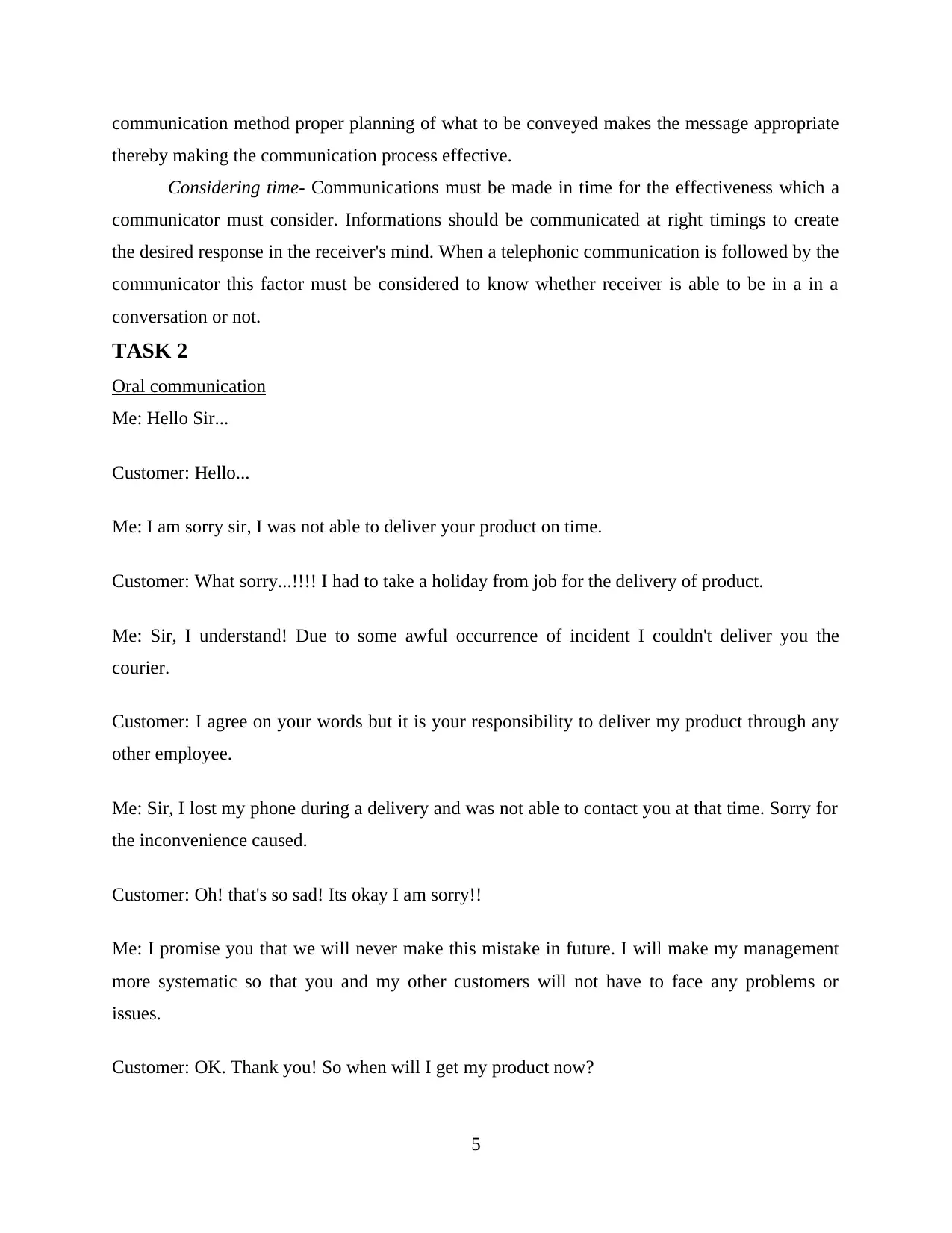
communication method proper planning of what to be conveyed makes the message appropriate
thereby making the communication process effective.
Considering time- Communications must be made in time for the effectiveness which a
communicator must consider. Informations should be communicated at right timings to create
the desired response in the receiver's mind. When a telephonic communication is followed by the
communicator this factor must be considered to know whether receiver is able to be in a in a
conversation or not.
TASK 2
Oral communication
Me: Hello Sir...
Customer: Hello...
Me: I am sorry sir, I was not able to deliver your product on time.
Customer: What sorry...!!!! I had to take a holiday from job for the delivery of product.
Me: Sir, I understand! Due to some awful occurrence of incident I couldn't deliver you the
courier.
Customer: I agree on your words but it is your responsibility to deliver my product through any
other employee.
Me: Sir, I lost my phone during a delivery and was not able to contact you at that time. Sorry for
the inconvenience caused.
Customer: Oh! that's so sad! Its okay I am sorry!!
Me: I promise you that we will never make this mistake in future. I will make my management
more systematic so that you and my other customers will not have to face any problems or
issues.
Customer: OK. Thank you! So when will I get my product now?
5
thereby making the communication process effective.
Considering time- Communications must be made in time for the effectiveness which a
communicator must consider. Informations should be communicated at right timings to create
the desired response in the receiver's mind. When a telephonic communication is followed by the
communicator this factor must be considered to know whether receiver is able to be in a in a
conversation or not.
TASK 2
Oral communication
Me: Hello Sir...
Customer: Hello...
Me: I am sorry sir, I was not able to deliver your product on time.
Customer: What sorry...!!!! I had to take a holiday from job for the delivery of product.
Me: Sir, I understand! Due to some awful occurrence of incident I couldn't deliver you the
courier.
Customer: I agree on your words but it is your responsibility to deliver my product through any
other employee.
Me: Sir, I lost my phone during a delivery and was not able to contact you at that time. Sorry for
the inconvenience caused.
Customer: Oh! that's so sad! Its okay I am sorry!!
Me: I promise you that we will never make this mistake in future. I will make my management
more systematic so that you and my other customers will not have to face any problems or
issues.
Customer: OK. Thank you! So when will I get my product now?
5
Secure Best Marks with AI Grader
Need help grading? Try our AI Grader for instant feedback on your assignments.
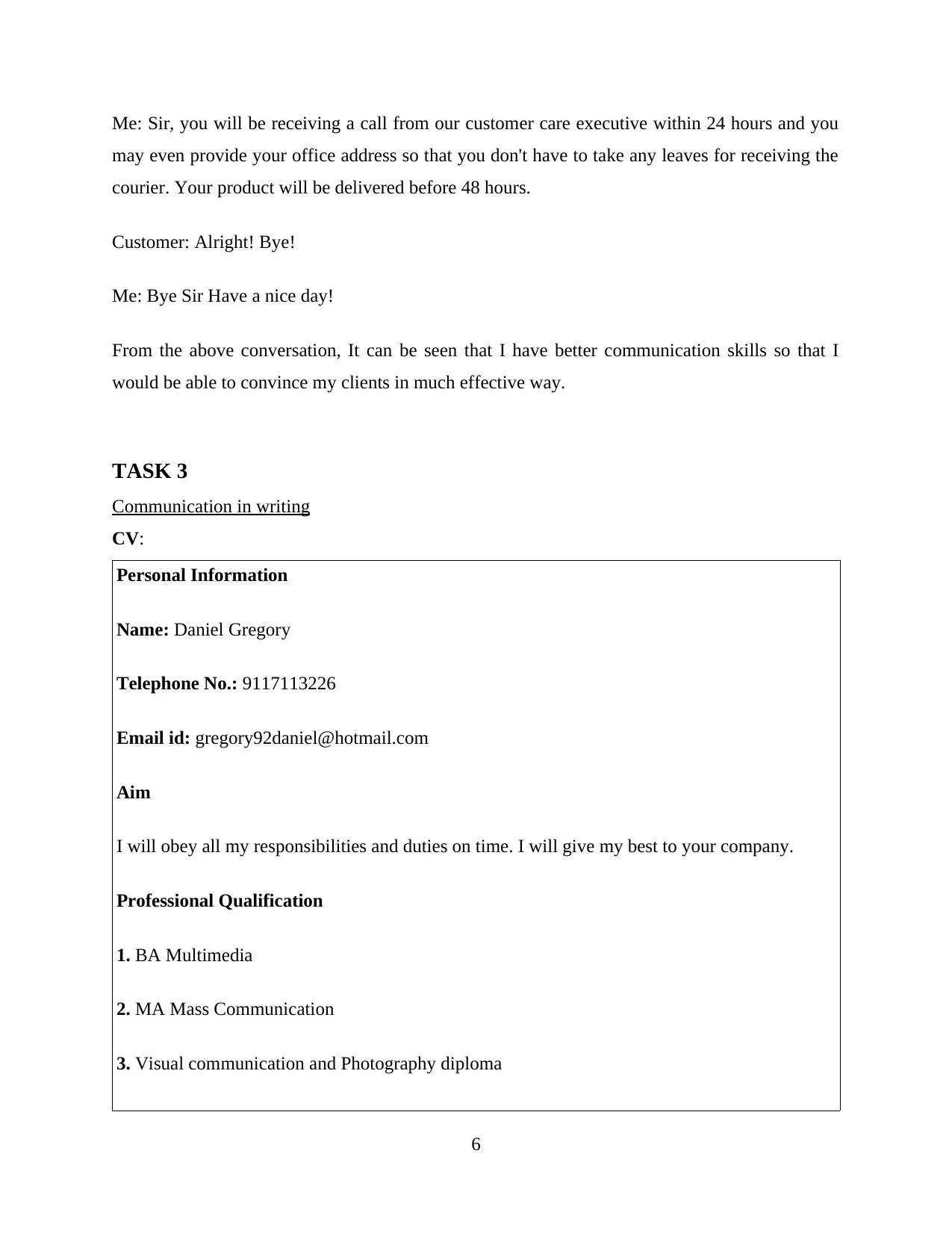
Me: Sir, you will be receiving a call from our customer care executive within 24 hours and you
may even provide your office address so that you don't have to take any leaves for receiving the
courier. Your product will be delivered before 48 hours.
Customer: Alright! Bye!
Me: Bye Sir Have a nice day!
From the above conversation, It can be seen that I have better communication skills so that I
would be able to convince my clients in much effective way.
TASK 3
Communication in writing
CV:
Personal Information
Name: Daniel Gregory
Telephone No.: 9117113226
Email id: gregory92daniel@hotmail.com
Aim
I will obey all my responsibilities and duties on time. I will give my best to your company.
Professional Qualification
1. BA Multimedia
2. MA Mass Communication
3. Visual communication and Photography diploma
6
may even provide your office address so that you don't have to take any leaves for receiving the
courier. Your product will be delivered before 48 hours.
Customer: Alright! Bye!
Me: Bye Sir Have a nice day!
From the above conversation, It can be seen that I have better communication skills so that I
would be able to convince my clients in much effective way.
TASK 3
Communication in writing
CV:
Personal Information
Name: Daniel Gregory
Telephone No.: 9117113226
Email id: gregory92daniel@hotmail.com
Aim
I will obey all my responsibilities and duties on time. I will give my best to your company.
Professional Qualification
1. BA Multimedia
2. MA Mass Communication
3. Visual communication and Photography diploma
6
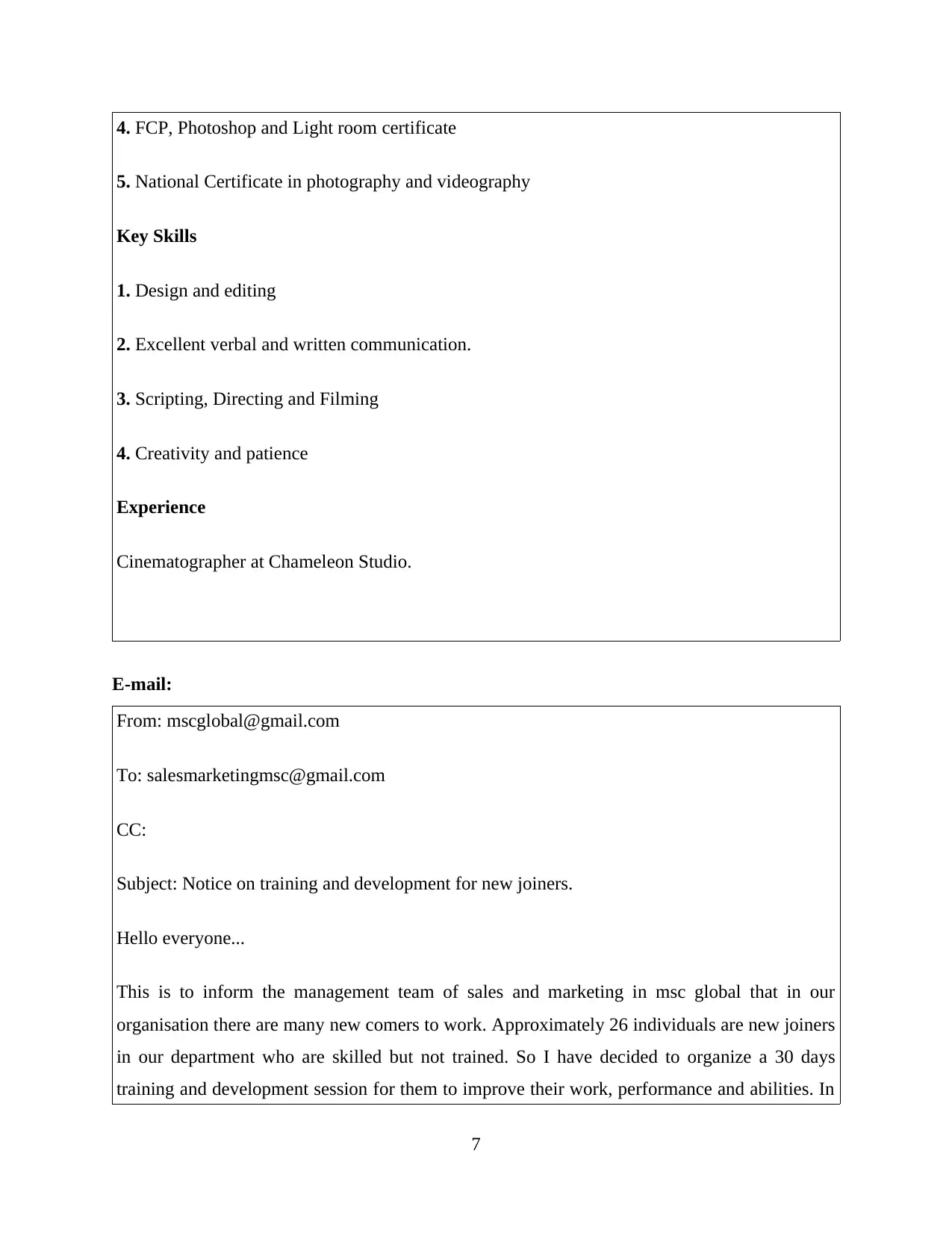
4. FCP, Photoshop and Light room certificate
5. National Certificate in photography and videography
Key Skills
1. Design and editing
2. Excellent verbal and written communication.
3. Scripting, Directing and Filming
4. Creativity and patience
Experience
Cinematographer at Chameleon Studio.
E-mail:
From: mscglobal@gmail.com
To: salesmarketingmsc@gmail.com
CC:
Subject: Notice on training and development for new joiners.
Hello everyone...
This is to inform the management team of sales and marketing in msc global that in our
organisation there are many new comers to work. Approximately 26 individuals are new joiners
in our department who are skilled but not trained. So I have decided to organize a 30 days
training and development session for them to improve their work, performance and abilities. In
7
5. National Certificate in photography and videography
Key Skills
1. Design and editing
2. Excellent verbal and written communication.
3. Scripting, Directing and Filming
4. Creativity and patience
Experience
Cinematographer at Chameleon Studio.
E-mail:
From: mscglobal@gmail.com
To: salesmarketingmsc@gmail.com
CC:
Subject: Notice on training and development for new joiners.
Hello everyone...
This is to inform the management team of sales and marketing in msc global that in our
organisation there are many new comers to work. Approximately 26 individuals are new joiners
in our department who are skilled but not trained. So I have decided to organize a 30 days
training and development session for them to improve their work, performance and abilities. In
7
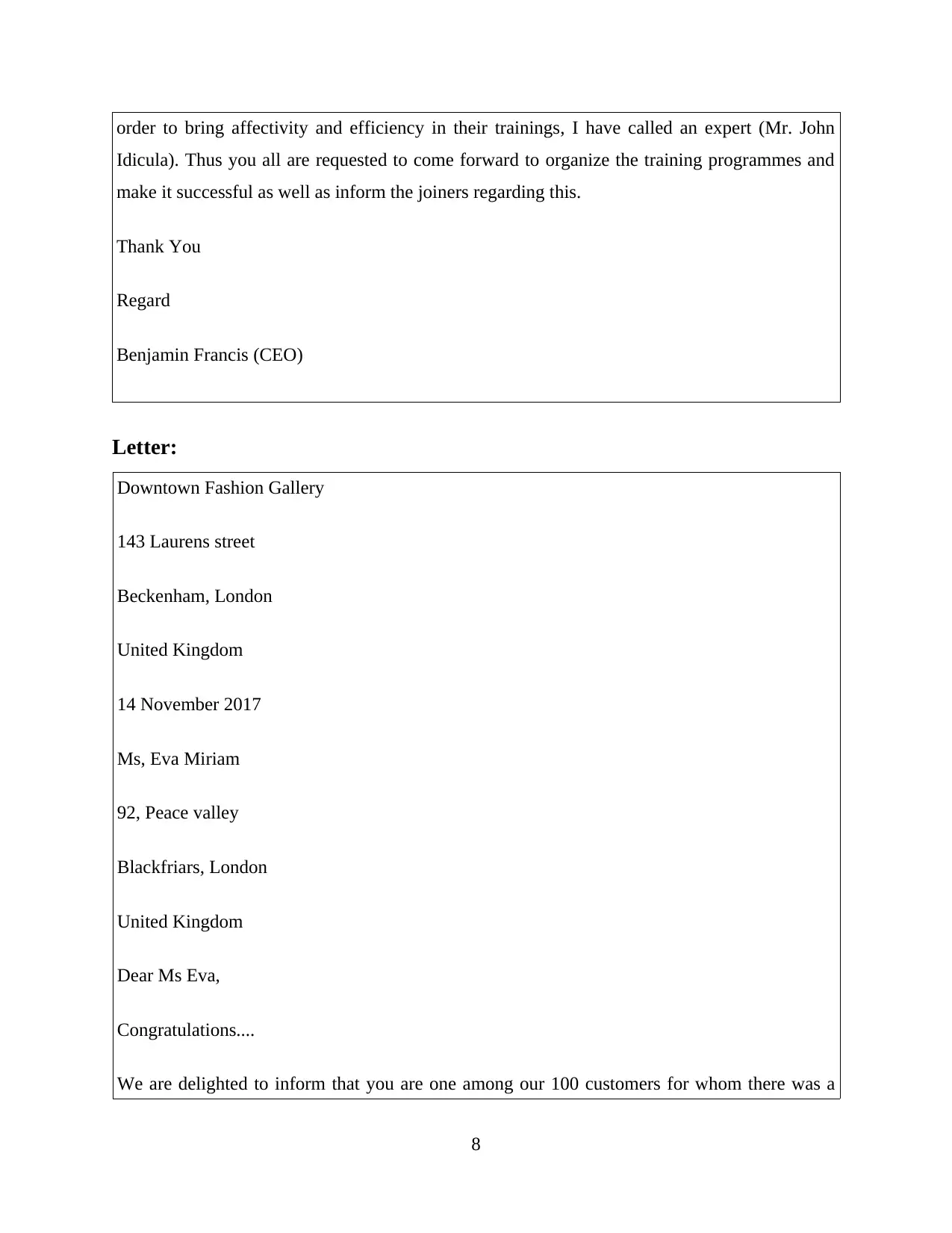
order to bring affectivity and efficiency in their trainings, I have called an expert (Mr. John
Idicula). Thus you all are requested to come forward to organize the training programmes and
make it successful as well as inform the joiners regarding this.
Thank You
Regard
Benjamin Francis (CEO)
Letter:
Downtown Fashion Gallery
143 Laurens street
Beckenham, London
United Kingdom
14 November 2017
Ms, Eva Miriam
92, Peace valley
Blackfriars, London
United Kingdom
Dear Ms Eva,
Congratulations....
We are delighted to inform that you are one among our 100 customers for whom there was a
8
Idicula). Thus you all are requested to come forward to organize the training programmes and
make it successful as well as inform the joiners regarding this.
Thank You
Regard
Benjamin Francis (CEO)
Letter:
Downtown Fashion Gallery
143 Laurens street
Beckenham, London
United Kingdom
14 November 2017
Ms, Eva Miriam
92, Peace valley
Blackfriars, London
United Kingdom
Dear Ms Eva,
Congratulations....
We are delighted to inform that you are one among our 100 customers for whom there was a
8
Paraphrase This Document
Need a fresh take? Get an instant paraphrase of this document with our AI Paraphraser
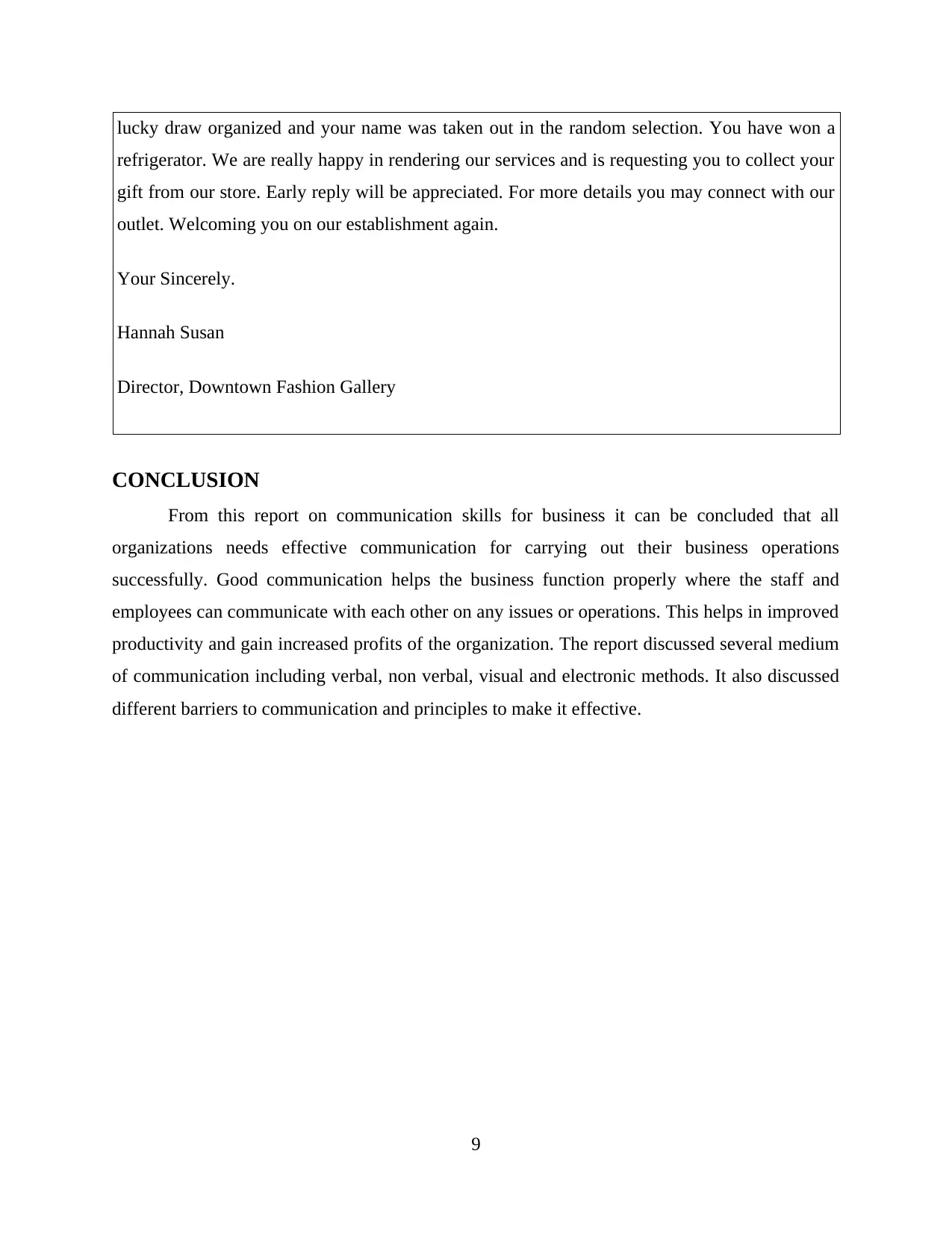
lucky draw organized and your name was taken out in the random selection. You have won a
refrigerator. We are really happy in rendering our services and is requesting you to collect your
gift from our store. Early reply will be appreciated. For more details you may connect with our
outlet. Welcoming you on our establishment again.
Your Sincerely.
Hannah Susan
Director, Downtown Fashion Gallery
CONCLUSION
From this report on communication skills for business it can be concluded that all
organizations needs effective communication for carrying out their business operations
successfully. Good communication helps the business function properly where the staff and
employees can communicate with each other on any issues or operations. This helps in improved
productivity and gain increased profits of the organization. The report discussed several medium
of communication including verbal, non verbal, visual and electronic methods. It also discussed
different barriers to communication and principles to make it effective.
9
refrigerator. We are really happy in rendering our services and is requesting you to collect your
gift from our store. Early reply will be appreciated. For more details you may connect with our
outlet. Welcoming you on our establishment again.
Your Sincerely.
Hannah Susan
Director, Downtown Fashion Gallery
CONCLUSION
From this report on communication skills for business it can be concluded that all
organizations needs effective communication for carrying out their business operations
successfully. Good communication helps the business function properly where the staff and
employees can communicate with each other on any issues or operations. This helps in improved
productivity and gain increased profits of the organization. The report discussed several medium
of communication including verbal, non verbal, visual and electronic methods. It also discussed
different barriers to communication and principles to make it effective.
9
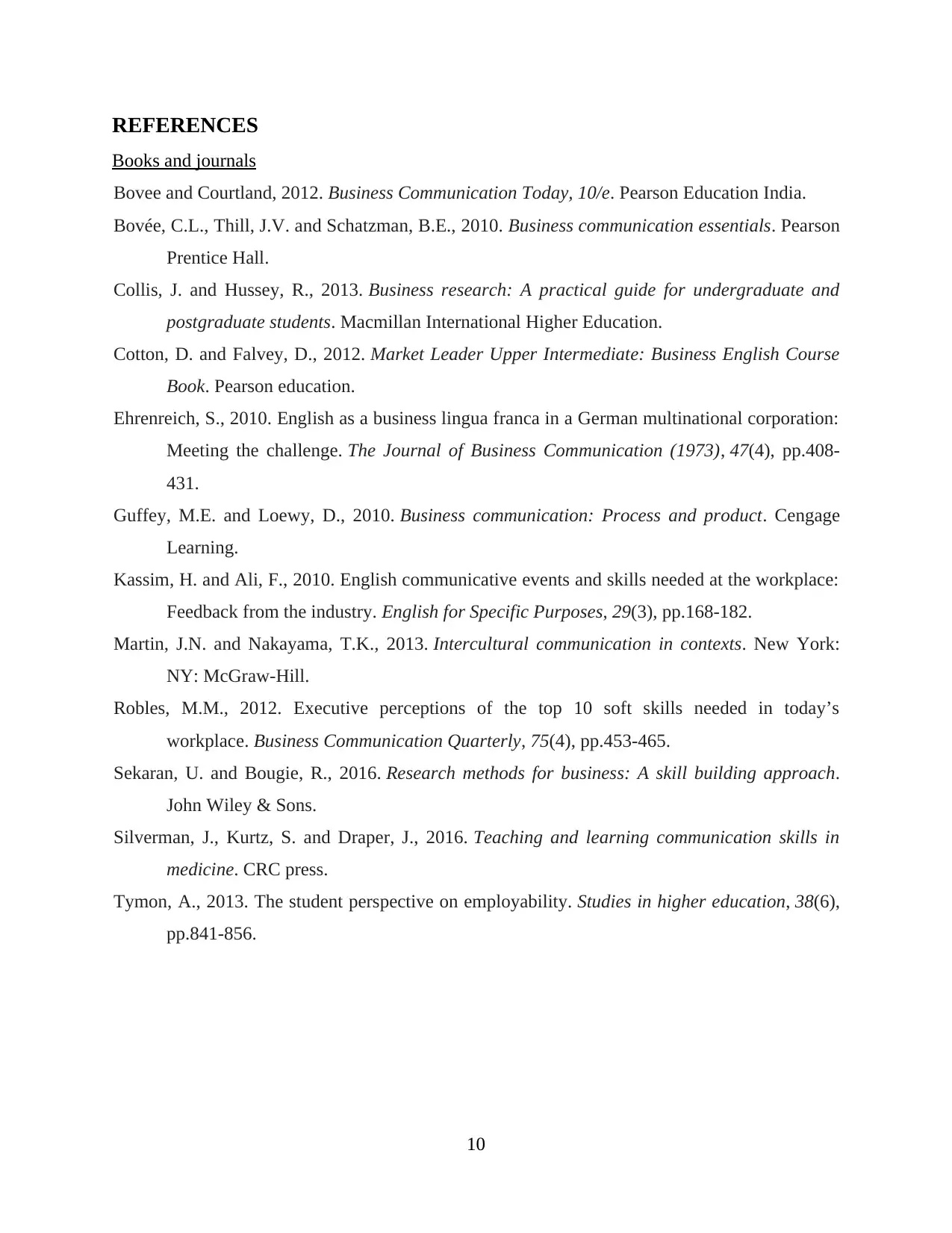
REFERENCES
Books and journals
Bovee and Courtland, 2012. Business Communication Today, 10/e. Pearson Education India.
Bovée, C.L., Thill, J.V. and Schatzman, B.E., 2010. Business communication essentials. Pearson
Prentice Hall.
Collis, J. and Hussey, R., 2013. Business research: A practical guide for undergraduate and
postgraduate students. Macmillan International Higher Education.
Cotton, D. and Falvey, D., 2012. Market Leader Upper Intermediate: Business English Course
Book. Pearson education.
Ehrenreich, S., 2010. English as a business lingua franca in a German multinational corporation:
Meeting the challenge. The Journal of Business Communication (1973), 47(4), pp.408-
431.
Guffey, M.E. and Loewy, D., 2010. Business communication: Process and product. Cengage
Learning.
Kassim, H. and Ali, F., 2010. English communicative events and skills needed at the workplace:
Feedback from the industry. English for Specific Purposes, 29(3), pp.168-182.
Martin, J.N. and Nakayama, T.K., 2013. Intercultural communication in contexts. New York:
NY: McGraw-Hill.
Robles, M.M., 2012. Executive perceptions of the top 10 soft skills needed in today’s
workplace. Business Communication Quarterly, 75(4), pp.453-465.
Sekaran, U. and Bougie, R., 2016. Research methods for business: A skill building approach.
John Wiley & Sons.
Silverman, J., Kurtz, S. and Draper, J., 2016. Teaching and learning communication skills in
medicine. CRC press.
Tymon, A., 2013. The student perspective on employability. Studies in higher education, 38(6),
pp.841-856.
10
Books and journals
Bovee and Courtland, 2012. Business Communication Today, 10/e. Pearson Education India.
Bovée, C.L., Thill, J.V. and Schatzman, B.E., 2010. Business communication essentials. Pearson
Prentice Hall.
Collis, J. and Hussey, R., 2013. Business research: A practical guide for undergraduate and
postgraduate students. Macmillan International Higher Education.
Cotton, D. and Falvey, D., 2012. Market Leader Upper Intermediate: Business English Course
Book. Pearson education.
Ehrenreich, S., 2010. English as a business lingua franca in a German multinational corporation:
Meeting the challenge. The Journal of Business Communication (1973), 47(4), pp.408-
431.
Guffey, M.E. and Loewy, D., 2010. Business communication: Process and product. Cengage
Learning.
Kassim, H. and Ali, F., 2010. English communicative events and skills needed at the workplace:
Feedback from the industry. English for Specific Purposes, 29(3), pp.168-182.
Martin, J.N. and Nakayama, T.K., 2013. Intercultural communication in contexts. New York:
NY: McGraw-Hill.
Robles, M.M., 2012. Executive perceptions of the top 10 soft skills needed in today’s
workplace. Business Communication Quarterly, 75(4), pp.453-465.
Sekaran, U. and Bougie, R., 2016. Research methods for business: A skill building approach.
John Wiley & Sons.
Silverman, J., Kurtz, S. and Draper, J., 2016. Teaching and learning communication skills in
medicine. CRC press.
Tymon, A., 2013. The student perspective on employability. Studies in higher education, 38(6),
pp.841-856.
10
1 out of 12
Related Documents
Your All-in-One AI-Powered Toolkit for Academic Success.
+13062052269
info@desklib.com
Available 24*7 on WhatsApp / Email
![[object Object]](/_next/static/media/star-bottom.7253800d.svg)
Unlock your academic potential
© 2024 | Zucol Services PVT LTD | All rights reserved.




